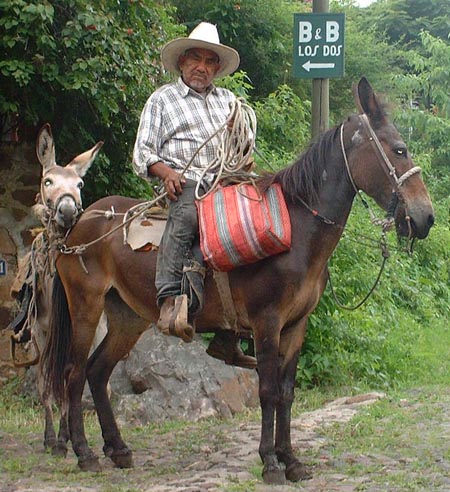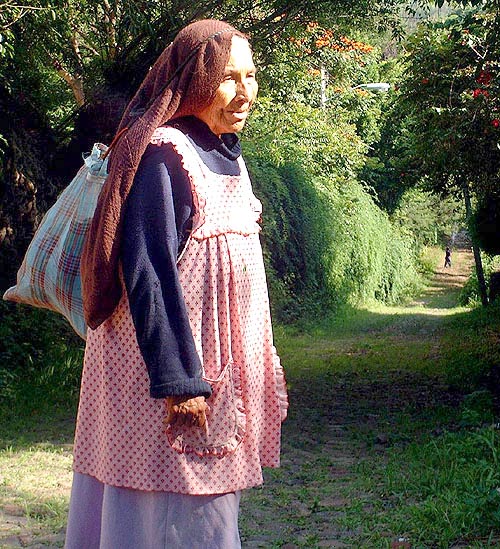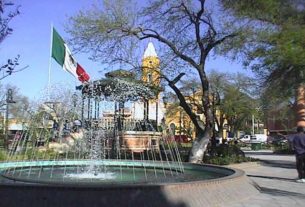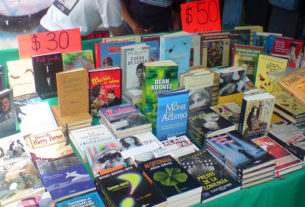We were finally moving to Mexico, but when I first learned the name of my new street, Calle Rico, I was very dismayed. That name, Rich Street, symbolized some of my concerns about our newly constructed home. Not only was it larger and fancier than any other structure far and wide, but it also was set on a hillside, from whence it seemed to peer down its sturdy brick nose at the humble barrio of Nestipac, which lay at its feet. On the outskirts of the larger village of Jocotepec, Nestipac then consisted of small two or three room adobe huts, albeit with cleanly swept dirt floors and roofs fashioned of straw petate mats, covered with tar paper and clay tiles or carrizo bamboo sticks.
With almost every Mexican town or village bearing street names of Independencia, Hidalgo, or 16th of Septiembre, how could I have been saddled with Rich Street? I noticed that every time I had to give my address, the officials, doctors or storekeepers thought they must have heard incorrectly.
I imagined they were thinking, It must be the señora’s imperfect foreign accent, or the rumble of the passing trucks.
“No,” I would assure them,” the street is Calle Rico,” as far as I knew, the only one with this unfortunate name in the entire nation.
Soon after we arrived, I was bemoaning the fact of being stuck on Rich Street to my dear friend, Ana. Originally an Albanian-American, Ana, like many of us, first felt she had truly come home when she arrived in Mexico. She had fallen in love, founded a thriving business, and was always a helpful source of tips on the culture and language of her beloved country.
“But Phyllis,” she laughed, “you have no problem. When you are asked for your address, first just say, Calle Rico. As soon as the other person raises his head or cocks her eyebrow, immediately follow that up with, You know, ‘ rico! sabroso!‘”
Since the word rico may also be translated as yummy or delicious, Ana had provided me with the perfect solution to my problem, and ever since I have followed her advice, leaving my inquisitors, I hope and imagine, with the vision of someone lucky enough to be living on yummy and delicious street!
Ana was correct in more ways than one, as it turned out. Whereas I, coming from a so-called first world society, had immediately translated Rico into rich with the attendant monetary connection, I was slowly to learn, or be reminded, of all the wealth in life that has nothing to do with bills or coins.

Though no one in Nestipac could ever enlighten me as to who had named my street or why, I eventually came to develop my own theories about Calle Rico, as I saw the farmers heading up the mountain in spring with their bags of corn seed, and coming down again in the fall, first with tender elotes, those pale yellow, young, juicy ears, later followed by the indispensable crop of corn, the treasure to be stored in the corner of the bedroom, a necessity for a years worth of tortillas, tamales and atole. Even later, on into December, the docile strings of burros passed my gate, only their long, velvety ears and tails still visible under the tall, tightly packed bundles of corn stalks and dried bean plants. The dry stalks hanging down behind the donkeys rears, rustled and shushed, a snare drum counterpoint to the rattattoo of the burros hooves. Thus they provided their own fodder for the coming winter. When the harvest was complete, the cows and goats were herded up Calle Rico to the mountain, where they feasted on the harvest leftovers and the stalks of all the autumn wildflowers. I came to feel there was little music to compare with the sound of a hundred dainty goat hooves tripping up Calle Rico.

At that time, most of the Nestipac housewives still cooked with wood, and the mornings were redolent with the mixed aromas of wood smoke, and freshly made tortillas wafting up from the barrio. Of course the donkeys did double duty, also carrying down all the small logs, sticks and twigs needed to keep the kitchen fires lit. Some of the older folks, lacking a burro or children, had to cut their own wood and carry it in on their heads or in a large straw basket on their backs. I used to pity the ancient, bent-over elders, struggling under their loads, until the day octogenarian, Doña Vicenta, stopped by my gate to catch a breath and said, “I love to climb the mountain. But best of all I love getting to the top, where I am bathed by the four winds.”
When the cooler months rolled around, and we required leña to burn in our two fireplaces, we sent for Dona Berta. A browned and sinewy single woman, with two young children, she was a familiar sight, striding up Calle Rico with her two burros and an assortment of pied and happy looking mutts. Considering myself a newly minted feminist and a life-long animal lover, I was intrigued by Doña Berta. At first she symbolized for me the Nestipac version of a free, hardworking, independent woman. She usually responded to my buenos días with only a serious nod and continued on her way. Even when Dona Berta delivered our burros de leña, (firewood was measured in burro loads) small-talk was kept to a minimum. After all, the entire mountain was waiting with dead and dry wood to be sought, and a family at home to be fed.
Not only the source of food and wood, Calle Rico also leads to a favorite pilgrimage destination, since the chapel halfway up the mountain is dedicated to Mexico’s patron saint, the Virgin of Guadalupe. No matter when you pass, the little chapel is swept clear, the altar filled with flowers. I have often met families with young children dressed in white and carrying bouquets to thank the Virgin for an illness overcome or a wish fulfilled.
Don Ricardo is now the only remaining Nestipac campesino who still ascends the mountain by burro. He is in his eighties, and for many years he came and went to his corn field, situated on the back side of the mountain, accompanied by his lifelong friend, Don Jose. The day came, not too long ago, when Jose’s children insisted he sell his donkey. “It’s too dangerous. You’ll fall and break a hip or who knows what else!” Don Ricardo, being childless, has no one to forbid him the mountain and still passes daily. I didn’t learn, until recently, that he is better known by a shorter version of his name, Don Rico.
During the passage of thirty years, I have come to understand that Calle Rico, still narrow, steep and cobbled, is a principal path to the heights. For centuries it has led the way to food, warmth, spiritual inspiration, companionship. I know from my own journeys up the mountain that I have always returned grimy and exhausted, but with an indefinable something extra, happy and at peace. I am also now aware that I wouldn’t have traded my time on Calle Rico for anyplace else. Nor, knowing all that I do now, would I ever consider changing the name of my uniquely rich, yummy and delicious street, which has shared its true wealth with me in so many unexpected ways.



